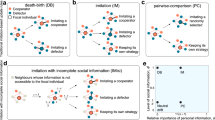Abstract
The imitation effects in a social group depend both on the size of the group and on the distribution of a certain psychobiological quantity ϕ which measures the tendency of an individual towards a given behavior. The distribution function of ϕ determines the ratio μ of the individuals in the society who adopt a given behavior. When the size of the social group is not too large, the actual distribution of ϕ will deviate from the most probable one, and therefore communities of the same size and having the same parameters may have different values of μ. Approximate equations are developed which give the probability of a given μ for a group of a given size. Possible effects of interactions of communities of different sizes are briefly discussed. A generalization of the theory of imitative behavior to any number of mutually exclusive behaviors is given, and its possible sociological implications are discussed.
Similar content being viewed by others
Literature
Landahl, H. D. 1938. “A Contribution to the Mathematical Biophysics of Psychophysical Discrimination.”Psychometrika,3, 107–25.
— 1941a. “Studies in the Mathematical Biophysics of Discrimination and Conditioning I.”Bull. Math. Biophysics,3, 13–26.
— 1941b. “Studies in the Mathematical Biophysics of Discrimination and Conditioning II. Special Case: Errors, Trials, and Number of Possible Responses.”Ibid., 71–7.
Landau, H. G. “Note on the Effect of Imitation in Social Behavior.”Bull Math. Biophysics,12, 221–35.
Mills, C. Wright. 1956.The Power Elite. New York: Oxford University Press.
Rashevsky, N. 1949a. “Mathematical Biology of Social Behavior.”Bull. Math. Biophysics,11, 105–13.
— 1949b. “Mathematical Biology of Social Behavior: II.”Ibid.,11, 157–63.
— 1949c. “Mathematical Biology of Social Behavior: III.”Ibid.,11, 255–71.
— 1950a. “Psychophysical Discrimination with More than Two Stimuli.”Ibid.,12, 215–20.
—. 1950b. “Mathematical Biology of Social Behavior: IV. Imitation Effects as a Function of Distance.”Ibid.,12, 177–85.
—. 1951a.Mathematical Biology of Social Behavior. Chicago: The University of Chicago Press.
—. 1951b. “A Note on Imitative Behavior and Information.”Ibid.,13, 147–51.
—. 1953. “Imitative Behavior in Nonuniformly Spatially Distributed Populations.”Ibid.,15, 63–71.
—. 1956. “Studies in Mathematical Biosociology of Imitative Behavior: I. Effects of Income Distribution.”Ibid.,18, 323–36.
Author information
Authors and Affiliations
Rights and permissions
About this article
Cite this article
Rashevsky, N. Contributions to the theory of imitative behavior. Bulletin of Mathematical Biophysics 19, 91–119 (1957). https://doi.org/10.1007/BF02477882
Issue Date:
DOI: https://doi.org/10.1007/BF02477882




